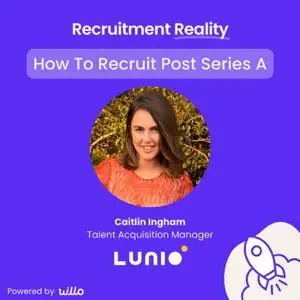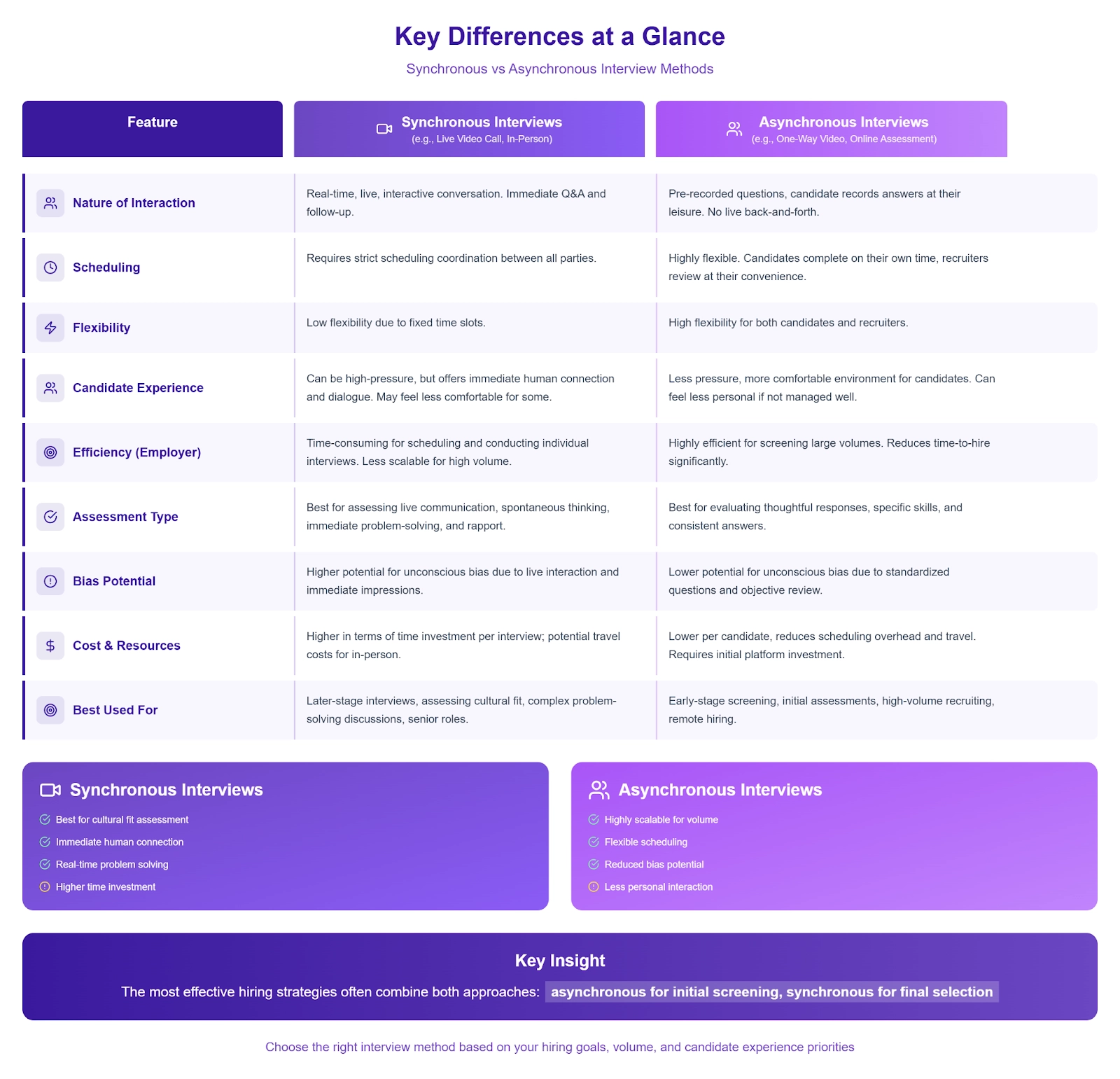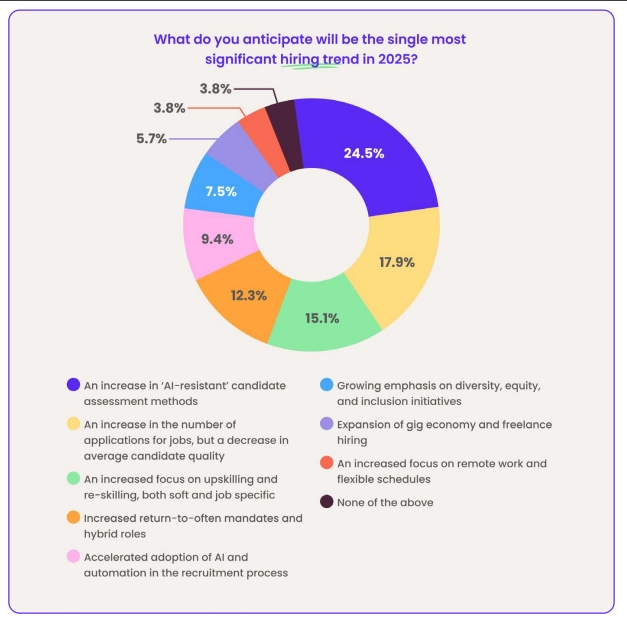At the heart of any organizational hiring process is interviewing—it’s how you get to know your applicants better and, ultimately, decide who is right for the job.
But if you’ve ever:
- Lost a stellar candidate because your process took too long (while competitors moved faster)
- Had interviewers clash over a hire because one prioritized skills and another valued "gut feel”
- Felt overwhelmed screening hundreds of applications, only to realize half didn’t meet basic requirements
You know how broken traditional hiring can be. Time drains. Misaligned teams. Top talent slipping away.
Having spoken with global talent professionals almost every day for the past eight years, I've observed a multitude of successful interview processes, ranging from those implemented by enterprises to innovative mid-sized startups.
What connects them all? A structured approach to the 5 key interview stages. In this Willo guide, I'll walk you through each one, with practical fixes to:
- Speed up hiring without rushing decisions or compromising on quality.
- Align your team with structured evaluations (so everyone agrees on who to hire).
- Handle high-volume applications efficiently, whether you’re hiring for one role or 100.
What Are The Stages of a Job Interview Process?
The stages of a job interview process are the steps an employer designs to progressively narrow down the candidate pool and identify the best fit for a role. During the interviewing process, there’s a lot you need to learn about a candidate before you can confidently say, “Yes, you’re the one.” This includes getting to know their background, skills, and experience, as well as their ability to fit into your team’s culture.
Interview stages are a way to gather this information in an organized, thorough way. Each stage in an interview process is defined by a goal (e.g., “measure a candidate’s technical skills”) as well as the specific interview format, questions, tasks, or exercises you’ll use to achieve that goal.
For example, the screening stage is a common interview stage.
The goal here is (usually) to gain a baseline understanding of the skills, experience, and background of a large group of candidates to quickly cut obvious bad-fits and move the potential-good-fits through to the next step. To accomplish this, you could use an async interview tool like Willo and a set of questions based on your job description.
The 5 Key Job Interview Stages You Need to Know
The five key stages of a job interview are:
- Application: To filter out a large group of potential candidates and narrow it down to those who fit the job description.
- Screening: To get a baseline understanding of the candidate’s skills, experience, and qualifications.
- Assessment: To evaluate the candidate’s skills and knowledge in more depth and decide if they have the potential to handle the job.
- Role fit: To determine whether the candidate is a good fit for the position and team.
- Cultural fit: To assess how the candidate will fit into the company, its values, and the working environment.
While these five stages represent the standard framework, there isn’t a “right way” to structure your interview process. Many interview processes have similar stages, since employers generally have a similar hiring goal—finding the best possible hire in the least amount of time.
You might opt for six or eight interview stages when hiring for an executive-level position, for example, as the complexity of the role often dictates a more extensive evaluation.
It's also important to note that the order of these stages can be flexible. For highly technical roles requiring precise skills, you might conduct an assessment before a general screening.
Many companies combine "Role Fit" and "Cultural Fit" into a single round or integrate them into a comprehensive "super day" interview format. Regardless of the specific structure or number of rounds, these core stages are essential, in some form, to ensure you hire the right candidate.
Let's delve deeper into each of these five stages to understand what they entail and how to best prepare your team.
1. Application
The application stage is also known as the pre-screening stage of the job interview. Here, your goal is to find out who is interested in the job and whether they meet the minimum requirements.
In this initial phase, most organizations aim to verify basic, non-negotiable criteria such as age, minimum years of experience, or specific location requirements. Verifying these upfront ensures your hiring team doesn't waste valuable time screening candidates who cannot, for practical reasons, be hired
Beyond these standard requirements, you can also pre-screen applicants based on criteria tailored to your specific role and recruitment policies. This approach optimizes your ability to identify candidates most likely to succeed in the role, rather than simply those with the most years of experience.
Caitlin Ingham, from Lunio, shared one of the most insightful examples of this application process I've seen. At Lunio, she designed an interview process that prioritized screening candidates based on "culture add" rather than solely "culture fit." Her approach involved specific interview questions designed to test how candidates aligned with Lunio’s cultural values and the unique skills required for success in a role.
This innovative approach led to fascinating talent discoveries within the candidate pool. For instance, a candidate who is now an SDR for Lunio stood out by answering "tell us something you've learned in the last year" with a quirky example about "snake slivers," indicating a genuine value for personality and uniqueness over rote answers.
A significant benefit of this approach is its contribution to creating a more diverse talent shortlist, fostering true inclusivity rather than conformity. However, it certainly requires creativity and a collaborative effort from the hiring team.
Here’s Caitlin’s perspective:

“We moved away from the culture fit statement because we don't want everyone to fit in a box. It's not what we're about. It doesn't really align with our values. So we are more of a culture-add focus when you join the business. We consider what you can bring? I think my advice would probably be to grow with curiosity. Like, get your creative hat on and ask] How can you fast-track your own development? Ask the questions, sit with the teams.”
You can Listen to the full story and read more creative recruitment examples
Key activities for employers in the application stage
There are three key activities in the application and pre-screening stage:
- Attract applicants: Write and share a job post that sets clear expectations and attracts suitable candidates.
- Collect and filter applications: Set up an ATS to collect candidate applications, manage candidate data, and filter the pool based on initial screening questions.
- Rank and categorize the applications: Candidates might be ranked (e.g., "strong," "moderate," "weak") or categorized (e.g., "to screen," "reject," "hold for future roles").
The key activities in the application stage might differ from one organization to the next. Nonetheless, your overarching goal for the stage is to efficiently build a qualified and diverse candidate pipeline for the next steps (screening).
As a result, you want to aim to:
- Attract enough, but not too many, qualified applicants: A high volume of unqualified applicants can overwhelm resources.
- Quickly identify and filter out unsuitable candidates: Saving time and resources for both the company and the candidates.
- Ensure compliance: Adhering to equal employment opportunity (EEO) guidelines and data privacy regulations (e.g., GDPR, CCPA).
- Create a positive initial candidate experience: Even for those who aren't selected, a smooth application process reflects well on the company's brand.
Related: How To Improve Candidate Experience
What should you ask candidates in the application stage?
Interview questions in the application stage should focus on gathering essential information and quickly assessing a candidate’s basic qualifications and alignment with the role.
Here are the types of questions typically asked [with examples]:
Basic qualification/knock-out questions
These are often "knockout" questions designed to quickly determine if a candidate meets non-negotiable requirements.
Examples of knock questions:
- "Do you have [X years] of experience in [specific skill/industry]?"
- "Do you possess the required [certification/license] for this role?"
- "Are you legally authorized to work in [country/location]?"
Motivation and fit questions
These aim to understand the candidate's initial interest and perceived fit. Examples:
- "What interests you about this specific role?"
- "Why are you interested in working for our company?"
- "Tell us a little bit about yourself and your career goals."
Experience and skills questions
These confirm the presence of key experience and skills without delving into extensive detail yet. Here are some sample questions:
- "Could you briefly describe your experience with [key software/tool/process]?"
- "What are your top three skills you believe are most relevant to this position?"
- "Tell us about a time you applied [a specific skill] in a previous role."
Logistics and availability questions
Ask these questions to ensure practical compatibility. Examples are:
- "What are your salary expectations for this role?"
- "When would you be available to start if offered the position?"
- "Are you open to [travel/relocation] if required for the role?"
The key is to create a list of job criteria and then map your questions to each item. Questions should be clear, concise, and allow candidates to provide a quick, focused response. That way, you can rest assured you’re getting the most relevant information and pushing high-quality candidates to the screening stage.
What metrics should you measure in the application stage?
The application stage is crucial for building your candidate pipeline, and tracking the right metrics helps you understand the effectiveness of your job ads and identify areas for improvement.
Here are the key metrics to measure:
- Number of applicants: The total count of individuals who applied for your job opening is your top-of-funnel indicator. A healthy number of applicants suggests your job posting is reaching a wide audience and is appealing enough to generate interest. A low number might indicate issues with your job description, distribution channels, or employer brand.
- Source of hire effectiveness: Understanding where your applicants are coming from (e.g., LinkedIn, Indeed, company career page, etc) informs your recruitment budget and strategy. Without tracking this, a campus recruiter might wrongly assume that investing more in campus recruitment software and student activation programs would yield better hires.
- Application completion rate: Consider the percentage of candidates who start an application (e.g., click "Apply," begin filling out a form) and successfully complete and submit it. If you’re seeing a low completion rate, it might signal friction in your application process. Your application form might be too long, complex, and require too much unnecessary information.
- Diversity of applicants: This involves tracking demographic data of applicants, such as gender, ethnicity, age, disability status, veteran status, and other relevant diversity dimensions. Measuring diversity at the application stage allows you to assess if your outreach and job postings are attracting a broad range of candidates, or if unconscious biases might be present even before screening begins
Related: How to achieve diversity and inclusion in recruitment
2. Screening
The screening stage is about getting an early read on a candidate through questions and answers before you decide to invest more time in them.
What you screen for will depend on the job and its requirements—skills, experience, and personality are all worthwhile targets. Similarly, how you screen candidates is also flexible.
Generally, there are two methods you can use:
Synchronous screening
This is a very common method that involves scheduling a short (usually 15-30 minute) phone or video interview with each candidate.
During synchronous screening interviews, recruiters will usually:
- Make introductions and small talk.
- Ask screening questions and record answers.
- Field questions about the job and company.
- Explain the next steps.
Because synchronous assessment involves real-time interaction, it allows for immediate follow-up questions, clarification of answers, and a more natural conversational flow. This can be crucial for assessing communication skills, spontaneity, and problem-solving under pressure.
However, there are a few downsides to this method. For starters, it’s difficult to find time slots that work for both the candidate and the recruiter (an issue that compounds as you scale). Then there are difficulties with scheduling reminders, follow-ups, tracking progress, sharing notes & comments, reviewing the interview, etc.
One potential solution?
Asynchronous screening
Asynchronous screening involves asking candidates to answer screening questions (via one-way video, audio, or text) without a recruiter needing to be physically present. Willo makes this simple—recruiters write (or generate) interview questions, send out invite links at scale, and review responses as they roll in.
.webp)
This approach eliminates the need to negotiate time slots and book meetings. Candidates can record answers at their convenience, making it easier for them to feel relaxed and speak freely.
Seen the benefits of asynchronous screening? Discover how Willo helps you screen more candidates in less time - book your demo today.
Recruiters also benefit from asynchronous screening because they get to work on their own time. No more setting meetings or chasing down candidates—the answers all come to them. Plus, recruiters can review answers at their own speed and decide whom to bring on for the next round of interviews.
The image below shows the key differences between synchronous and asynchronous interviews.

Questions to ask candidates in the screening stage
The questions at this stage are designed to confirm qualifications, assess core skills, and gauge initial fit, allowing you to efficiently narrow down the candidate pool.
Here are examples of questions to ask candidates during the screening stage:
Questions to validate experience and background
- "Can you briefly describe your experience in [specific industry/domain]?"
- "How many years of experience do you have with [specific technology/tool/process]?"
- "In your previous role at [Company Name], what were your primary responsibilities related to [key job duty]?"
- "Could you elaborate on your experience managing projects of [specific size/complexity]?"
Skills-based questions
- "What is your familiarity with [specific software/platform]?"
- "How would you rate your proficiency in [critical skill, e.g., data analysis, customer service, coding language] on a scale of 1 to 5?"
- "Tell us about a time you had to use [specific skill] to solve a problem."
Motivational & interest questions
- "What specifically attracted you to this role at our company?"
- "What are you hoping to achieve in your next position that you couldn't in your last?"
- "Based on the job description, which aspects of this role excite you the most?"
Work style & environment question
- "Do you prefer working independently or collaboratively, and why?"
- "How do you typically manage deadlines and prioritize tasks?"
- "What kind of work environment do you thrive in?"
What metrics should you measure in the screening stage of the interview?
- Screening completion rate: This metric helps you understand what percentage of candidates start the screening process (e.g., begin a phone screen, open an asynchronous assessment) and successfully complete it. A low completion rate could indicate that your screening process is too lengthy, complex, or off-putting to candidates. For instance, screening processes that require app downloads or sign-ups often lead to high drop-off among candidates.
- Pass-through rate: This is the percentage of screened candidates who are deemed suitable and are invited to proceed to the next stage of the interview process (e.g., a formal interview with a hiring manager or an in-depth assessment). A high pass-through rate suggests your screening criteria are effective at identifying good candidates, while a very low rate might mean your initial screening is too stringent or your application stage isn't attracting enough qualified individuals.
- Time to screen: How long does it take to screen a candidate, from when they enter the screening stage to when a decision is made to advance or reject them? This metric is essential if you’re in high-volume recruiting, as it directly impacts your overall time-to-hire.
- Cost per screen: If you’re looking for opportunities to reduce expenses without compromising quality, this is where you want to look. Cost per screen calculates the resources (e.g., recruiter time, software costs, administrative overhead) spent for each candidate screened.
Related: How To Calculate and Improve Time to Hire
3. Assessment
The talent assessment stage is all about attaching qualitative and quantitative facts to the interview process. And while many companies skip this stage, it can be invaluable in making sure the right candidate is chosen.
The assessment stage is distinct from the screening stage. Screening aims for a baseline understanding. Assessment delves deeper into a candidate's actual potential to handle the job responsibilities.
Assessments could come in the form of:
- Skills tests: To provide insights into a candidate’s specific job abilities and technical skills.
- Personality tests: To provide insights into a candidate’s strengths and weaknesses.
- Cognitive ability tests: To provide insights into a candidate’s learning and problem-solving abilities.
- Situational judgment tests: To provide insights into how a candidate responds to specific job-related scenarios.
Once again, there are synchronous and asynchronous ways to conduct the assessment stage:
Synchronous assessment
Synchronous assessment involves assessing the candidate in real-time, usually via video calls, live exercises, or in-person interviews.
Asynchronous assessment
Asynchronous assessment allows candidates to complete tasks or answer questions at their convenience, without the need for real-time interaction with an interviewer.
One-way interview tools like Willo can be of great help in the assessment stage. You can create dedicated assessment interviews, set time limits for responses, allow for text, video, and audio responses.
Alternatively, there are tons of test-based assessment tools out there. For example, Arctic Shores helps you assess candidates on key job-relevant skills using AI-proof tasks and questions. You can then generate reports on each candidate to decide if they're suitable for the position.
How to Conduct Asynchronous Interviews
1. Develop questions
When drafting questions, consider the goal of the interview stage a candidate is at and the criteria you’re looking for at that stage. For example, if you’re at the screening stage, you probably don’t want to go too in-depth (this slows down the review process).
Come up with a list of criteria and work backwards to think of questions that will help you assess the candidate. If you’re writing technical or role-specific questions, make sure you involve the relevant stakeholders.
Willo helps you beat writer's block with an interview question generator designed to get you the answers you need.
2. Set deadlines and time limits
As we mentioned, a major advantage of async video interviews is that candidates can record them at their own convenience. However, you can’t leave the interview open indefinitely because that doesn’t provide a reliable structure.
With a tool like Willo, you can set deadlines and time limits. Candidates can be given a deadline to respond, and the length of each video question can be limited. This keeps the process moving efficiently without sacrificing quality.
3. Establish a review process
You’ll need to determine how your team will review the interviews once they’re complete, so you can shortlist your candidates accordingly.
For example, you can select certain hiring managers to review the interviews or use Willo’s Showcase™ feature to securely share the interviews with multiple colleagues so that they can give their relevant feedback on candidates.
Related: Best candidate assessment software
Key considerations for effective async interview stages
1. Explain your process
Many candidates will be expecting a traditional hiring process.
While we’re well aware of the many benefits of async interviews, it’s important to explain what you’re doing and why. A simple overview of the steps involved, including the types of activities you’ll expect from the candidate and how much time they should expect to spend on it, helps ensure everyone is on the same page right out of the gate.
2. Make it personal
As sending applicants to a one-way interview can strip personal connection from the process, it’s important to add a personal touch elsewhere. For example, in the email you send sharing the interview link, you could add a personalized message to help candidates feel more comfortable conducting the interview.
3. Allow candidates to ask questions
Traditional interviews allow candidates to ask questions directly to the interviewer. Since this direct line of communication is lost in an async interview, you need to add it back in. You can do this by giving candidates a contact on the hiring team to reach out to with questions during the interview process.
4. Collect feedback
It’s important to continuously review whether your interview process works well for your candidates. Otherwise, you may lose some special talent.
After the interview, don't forget to ask candidates for their feedback on the interview process and the relevance of the questions. Similarly, gather feedback from your hiring team to ensure a smooth and effective interview process for everyone involved.
What metrics should you measure in the assessment stage of the interview?
Because the assessment stage evaluates specific skills, knowledge, and abilities in depth, you’re looking at long-term metrics like correlation between assessment performance and on-the-job performance.
This measures how well the assessment scores predict actual job success once the candidate is hired. This is crucial for validating the effectiveness and predictive power of your assessments.
4. Role fit
The role fit stage is a longer-form interview stage that’s focused on both “hard” and “soft” skills. At this stage, you should try to get a sense of how your candidate could fit into the job at hand—but also what kind of contributions they can make that go beyond just ticking boxes. To do so, it’s useful to ask in-depth questions that focus on experiences with:
Types of interview questions to assess a candidate’s role-fit are:
- Challenges (e.g., “Tell me about a project that went badly and what you did to turn it around”).
- Critical thinking (e.g., “How would you approach this client’s case?”).
- Problem-solving skills (e.g., “Describe a time when you had to come up with a new solution”).
- Skill set (e.g., “How would you go about testing this piece of code?”).
How you conduct these interviews will depend on your company’s structure and your hiring goals.
Larger companies with international offices and smaller companies hiring locally often handle role fit questions during their in-person job interviews. Live video interviews are popular with distributed teams who want to get a better sense of the candidate's personality.
However, you can still use async methods like one-way interviews to save time and increase recruiter capacity during the role fit stage. Just create a role fit interview, invite your shortlisted candidates, and review the recorded responses.
5. Cultural fit
The final stage of the interview process is typically a dedicated cultural fit stage.
While you’ve been gathering information on a candidate’s culture fit throughout the hiring process, it’s important to ensure that they will fit in with your team and company values. This is generally done through an informal chat or lunch with members of the team who are candidates for this role.
This is one area where async methods sometimes fall short. If the job you’re trying to fill involves a lot of face-to-face interaction, a face-to-face interview (either video or in-person) is the only way to get a sense of how a candidate will perform.
That said, there are plenty of jobs (especially with distributed teams) where cultural fit is more about work habits, values, and communication style than anything else. In these situations, async methods can be extremely helpful.
Expert Tips for Conducting Effective Interview Stages
Achieving a successful interview has become increasingly difficult for employers and recruiters today. An increasing talent shortage and skill gaps mean employers are often competing for a smaller pool of highly sought-after individuals.
Additionally, today's candidates, especially top talent, have high expectations. Not just for increased salary and benefits; they also want longer tenure and would consider your financial position before choosing you.
Where does that leave you today?
Here are some tips we often recommend to employers and recruiters today:
1. Automate basic recruitment tasks
A considerable portion of HR professionals (46%) feel their workloads are increasing due to disparate systems and manual processes, leading to errors and burnout.
Automating tasks like sending rejection emails and scheduling interviews can reduce those administrative burdens and free up your hiring team to handle human-centric aspects of recruitment, such as:
- Engaging more deeply with candidates during interviews.
- Refining interview questions and strategies to better assess cultural fit, problem-solving, and decision-making skills.
- Providing more tailored feedback and communication to candidates, which is crucial for a positive candidate experience, and builds trust
This approach significantly reduces time-to-hire. Your hiring team is not stretched thin. Also, the interview stage is populated with better-matched candidates.
2. Don’t fully outsource interview stages to AI
AI offers significant benefits in preliminary recruitment phases– no doubt. However, most talent professionals would tell you that outsourcing full decision-making to AI could undermine the interview process's effectiveness and fairness.

Talent leaders are learning that AI cannot handle high-level talent acquisition strategy needs, such as identifying talent gaps or spotting potential when a resume doesn't tell the whole story.
Therefore, overreliance on AI in recruitment could make the process impersonal, causing companies to miss out on top candidates.
Related: An In-depth Guide to AI in Recruitment
3. Ensure key interview stages are AI-proof
Job seekers are increasingly using AI to craft polished application materials that, in most cases, overestimate their true skills and experience level. This AI arms race is one of the reasons employers are seeing an increase in candidate quantity but a decrease in quality.

AI-proof assessment methods, such as video interviews and skills-based hiring, address this by providing ways to filter out candidates who may not genuinely possess the skills or fit for a role.
For instance, Willo allows you to test candidates with a mix of questions that require responses in video, audio, text, multiple-choice selection, and file uploads. It also provides anti-cheat that detects when candidates are reading answers from a source. You can also verify the applicant’s identity and right to work within the platform.
Related: How To Implement Skills-based Hiring
4. Look beyond the candidate’s resume
Successful recruitment in the modern landscape requires moving beyond a superficial resume review to delve into a candidate's true potential, motivation, values, and personality.
Understand that“Application” isn’t synonymous with “resume + cover letter”—both of these formats are prone to embellishment and filler. A better option is to get candidates to introduce themselves and what they believe makes them a fit for the role, leveraging either online forms or one-way video interview tools like Willo.
Dace, a Talent Acquisition Manager at SmartLynx, who successfully recruited aviation talent from among bankers, explains why you look beyond the candidate’s resume in the application stages.

It's about the person itself, it's about your motivation. We promote ourselves quite a lot as a place where you do not need a specific aviation background for positions like, let's say, operations. It's all about what you can bring, what value you can bring, and whether our values align with your values as a person.
Related: Top Hiring Challenge You Should Know
Optimize Your Interview Process Using Willo
Understanding the different stages of the interview process is a great way to conduct structured interviews, establish clear communication with candidates, and optimize candidate evaluation.
At Willo, we specialize in providing hiring managers with powerful tools to screen candidates effectively at scale. Willo integrates with popular ATS like Workable, Greenhouse, Teamtailor, and Lever to add async interviews, self-scheduling, and simplified review to the mix.
If you’re a company looking to accelerate your hiring processes—like airBaltic, who screened over 100 high-potential candidates in just 7 days with Willo—you’re in the right place.






